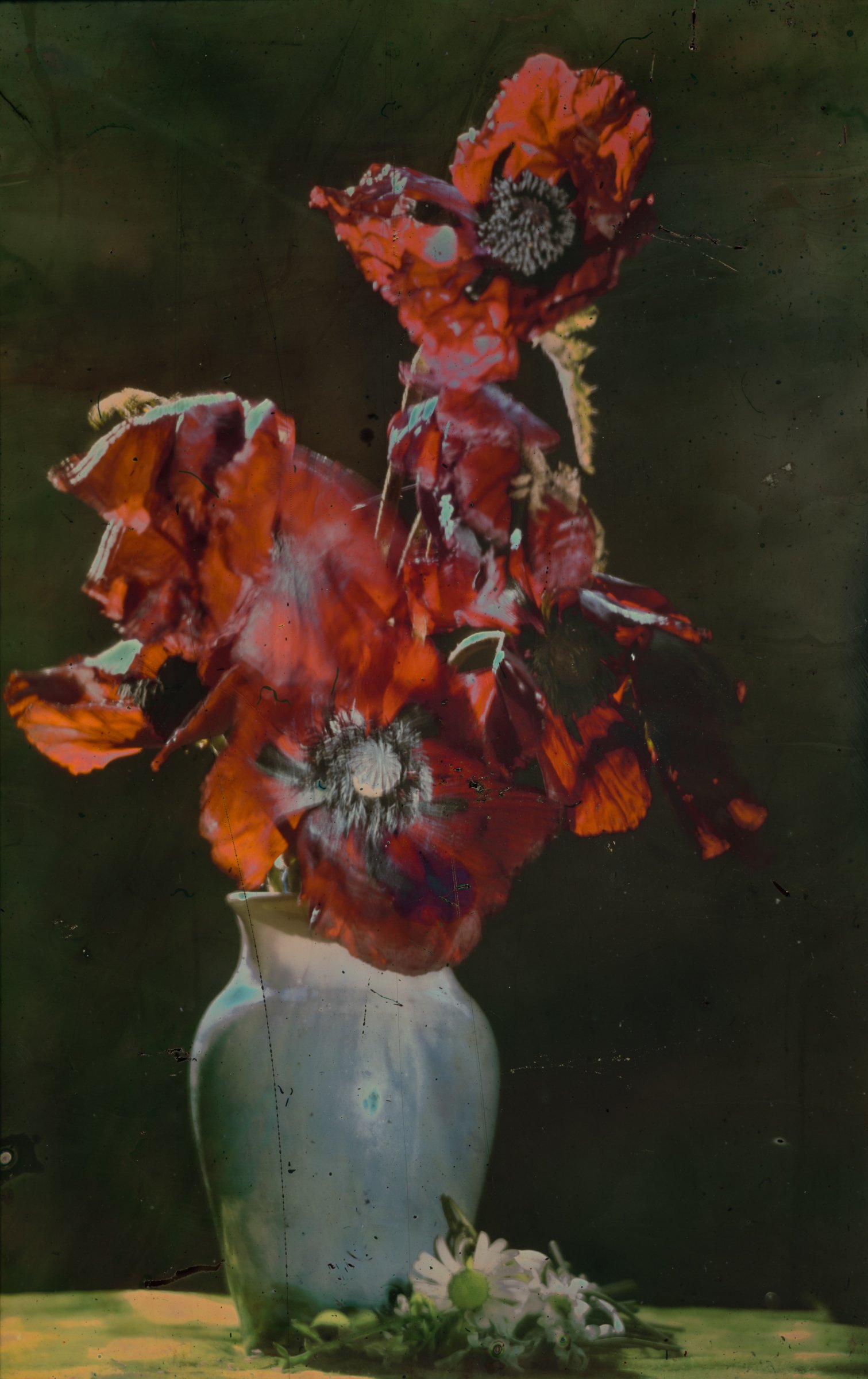Photo Elysée | Lausanne
3. März - 21. Mai 2023
La photographie des couleurs
Gabriel Lippmann
Gabriel et/ou Laurence Lippmann, Bouquet de pavots d’Orient, 1892-1910 © Collections Photo Elysée
Als Ergebnis einer Zusammenarbeit, die Photo Elysée seit einigen Jahren führt, macht diese Ausstellung auf Bilder aufmerksam, die aus dem im Museum aufbewahrten Fonds Gabriel Lippmann stammen und mittels der Interferenz-Technik (dem sogenannten Lippmann-Verfahren) hergestellt wurden – einem Herstellungsverfahren für Farbbilder, für das Gabriel Lippmann im Jahr 1908 den Nobelpreis für Physik erhielt. Das Museum bewahrt das grösste Ensemble von Platten auf, die von Lippmann selbst angefertigt und in einer Institution gesammelt wurden (d. h. 137 Platten von fast 300 Platten, die über alle Kontinente verteilt sind).
Da es sich bei den Lippmann-Platten um komplexe fotografische Objekte handelt, die am Schnittpunkt mehrerer Disziplinen verortet sind, fanden Begegnungen zwischen Forschern unterschiedlicher Fachbereiche, insbesondere des LCAV des EPFL, aber auch der Sorbonne Université statt. Die Lippmann-Platte erlaubt es auch, die materielle und technische Komplexität der Fotografie wahrzunehmen, die im Zeitalter der vollständigen Digitalisierung bisweilen verkannt oder vergessen wird.
Die Ausstellung ist in drei Schwerpunkte aufgeteilt, die den grossen Forschungsbereichen entsprechen, mit denen die Lippmann-Platten verbunden sind: die Lippmann-Platte als museologisches Objekt oder die Wichtigkeit der visuellen Erfahrung; die Lippmann-Platte als wissenschaftlicher Gegenstand oder die Wichtigkeit des technischen Verfahrens und schliesslich die Lippmann-Platte als Gegenstand der Kunstgeschichte oder die Wichtigkeit des Bildes. Die Ausstellung ist Teil eines grösserem Forschungsprojektes mit dem Ziel, einen Catalogue raisonné der Lippmann-Platten zu initiieren, das parallel durchgeführt wird und längerfristig angelegt ist (2025–2026).
Kuratorin: Pauline Martin
Wissenschaftliche Berater*innen: Manuel Sigrist, Nathalie Boulouch, Jean-Marc Fournier, Tatyana Franck, Martin Vetterli
Fruit d’un travail collaboratif mené depuis plusieurs années par Photo Elysée, cette exposition met en lumière des images provenant du Fonds Gabriel Lippmann conservé au musée et produites grâce à la technique interférentielle – procédé couleurs pour lequel Gabriel Lippmann a reçu le prix Nobel de physique en 1908.
Le musée conserve le plus grand ensemble de plaques réalisées par Lippmann lui-même et réunies dans une institution (soit 137 plaques sur près de 300 réparties sur tous les continents).
Les plaques Lippmann étant des objets photographiques complexes qui se situent au croisement de plusieurs disciplines, des rencontres entre des chercheurs de différents horizons, notamment du LCAV de l’EPFL mais aussi de Sorbonne Université ont eu lieu. La plaque Lippmann permet aussi de percevoir la complexité matérielle et technique de la photographie, parfois méconnue ou oubliée au temps du tout-numérique.
L’exposition se divise en trois axes qui répertorient les grands domaines de recherche dans lesquels les plaques Lippmann s’inscrivent : la plaque Lippmann comme objet muséographique ou l’importance de l’expérience visuelle ; la plaque Lippmann comme objet scientifique ou l’importance du procédé ; la plaque Lippmann comme objet d’histoire de l’art ou l’importance de l’image.
L’exposition a permis d’initier un projet du catalogue raisonné des plaques Lippmann, mené en parallèle et à un horizon plus lointain (2025-2026).
Commissariat: Pauline Martin
Conseil scientifique: Manuel Sigrist, Nathalie Boulouch, Jean-Marc Fournier, Tatyana Franck, Martin Vetterli
Frutto di una collaborazione condotta da più anni da Photo Elysée, questa mostra valorizza le immagini provenienti dal Fondo Gabriel Lippmann conservato presso il museo e prodotte grazie alla tecnica interferenziale – processo a colori per il quale Gabriel Lippmann ha ricevuto il premio Nobel di fisica nel 1908. Il museo conserva il più grande complesso di lastre realizzate dallo stesso Lippmann e riunite in un'unica istituzione (ossia 137 lastre su circa 300 ripartite su tutti i continenti).
Dato che le lastre Lippmann sono oggetti fotografici complessi che si trovano all'incrocio di più discipline, sono avvenuti incontri tra ricercatori provenienti da vari orizzonti, in particolare dal LCAV dell’EPFL ma anche dall'Università della Sorbonne. La lastra Lippmann permette altresì di percepire la complessità materiale e tecnica della fotografia, talvolta misconosciuta o dimenticata ai tempi del tutto digitale.
La mostra è divisa in tre assi che elencano i principali campi di ricerca nei quali si iscrivono le lastre Lippmann: la lastra Lippmann quale oggetto museografico o l'importanza dell'esperimento visivo ; la lastra Lippmann quale oggetto scientifico o l'importanza del processo, ed infine la lastra Lippmann quale oggetto di storia dell'arte o l'importanza dell'immagine. La mostra ha consentito di avviare un progetto di catalogo ragionato delle lastre Lippmann, condotto in parallelo e previsto a una data successiva a (2025-2026).
Curatrice: Pauline Martin
Consulenti scientifici: Manuel Sigrist, Nathalie Boulouch, Jean-Marc Fournier, Tatyana Franck, Martin Vetterli
This exhibition is the culmination of several years of collaborative work by Photo Elysée. It highlights images from the Gabriel Lippmann collection held at the museum and produced using the interferential technique - the color process for which Gabriel Lippmann was awarded the Nobel Prize in Physics in 1908. The museum holds the largest collection of plates made by Lippmann himself and gathered in one institution (137 plates out of nearly 300 spread over all continents).
Given the complexity of the Lippmann plates, at the crossroads of several disciplines, encounters took place between researchers from different horizons, notably from the LCAV of the EPFL, as well as from the Sorbonne University. The Lippmann plate also allows us to appreciate the material and technical complexity of photography, sometimes overlooked or forgotten in our digital age.
The exhibition is divided into three themes that cover the major fields of research of which the Lippmann plate is part: the Lippmann plate as a museum object, or the importance of the visual experience; the Lippmann plate as a scientific object, or the importance of the process; and, finally, the Lippmann plate as an object of art history, or the importance of the image. The exhibition has also made it possible to initiate a project for a catalogue raisonné of the Lippmann plates, which will be carried out in parallel at a later date (2025- 2026).
Curator: Pauline Martin
Scientific Advisors: Manuel Sigrist, Nathalie Boulouch, Jean-Marc Fournier, Tatyana Franck, Martin Vetterli
(Text: Photo Elysée, Lausanne)

